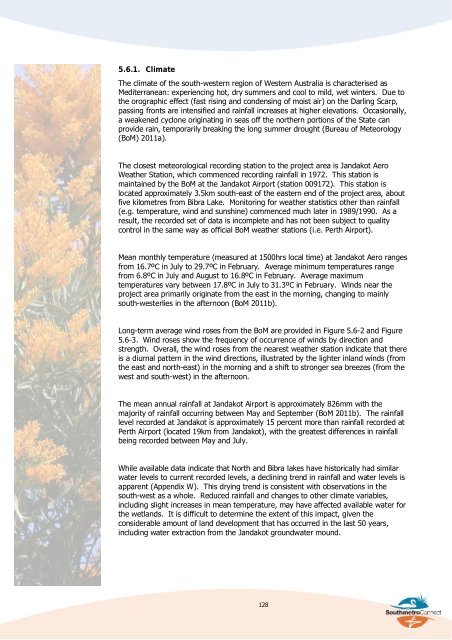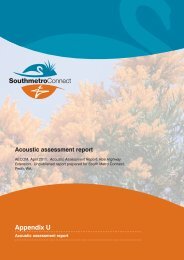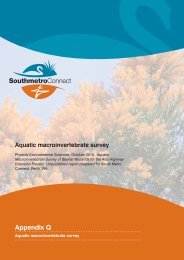Existing Environment - Interactive Investor
Existing Environment - Interactive Investor
Existing Environment - Interactive Investor
You also want an ePaper? Increase the reach of your titles
YUMPU automatically turns print PDFs into web optimized ePapers that Google loves.
5.6.1. Climate<br />
The climate of the south-western region of Western Australia is characterised as<br />
Mediterranean: experiencing hot, dry summers and cool to mild, wet winters. Due to<br />
the orographic effect (fast rising and condensing of moist air) on the Darling Scarp,<br />
passing fronts are intensified and rainfall increases at higher elevations. Occasionally,<br />
a weakened cyclone originating in seas off the northern portions of the State can<br />
provide rain, temporarily breaking the long summer drought (Bureau of Meteorology<br />
(BoM) 2011a).<br />
The closest meteorological recording station to the project area is Jandakot Aero<br />
Weather Station, which commenced recording rainfall in 1972. This station is<br />
maintained by the BoM at the Jandakot Airport (station 009172). This station is<br />
located approximately 3.5km south-east of the eastern end of the project area, about<br />
five kilometres from Bibra Lake. Monitoring for weather statistics other than rainfall<br />
(e.g. temperature, wind and sunshine) commenced much later in 1989/1990. As a<br />
result, the recorded set of data is incomplete and has not been subject to quality<br />
control in the same way as official BoM weather stations (i.e. Perth Airport).<br />
Mean monthly temperature (measured at 1500hrs local time) at Jandakot Aero ranges<br />
from 16.7ºC in July to 29.7ºC in February. Average minimum temperatures range<br />
from 6.8ºC in July and August to 16.8ºC in February. Average maximum<br />
temperatures vary between 17.8ºC in July to 31.3ºC in February. Winds near the<br />
project area primarily originate from the east in the morning, changing to mainly<br />
south-westerlies in the afternoon (BoM 2011b).<br />
Long-term average wind roses from the BoM are provided in Figure 5.6-2 and Figure<br />
5.6-3. Wind roses show the frequency of occurrence of winds by direction and<br />
strength. Overall, the wind roses from the nearest weather station indicate that there<br />
is a diurnal pattern in the wind directions, illustrated by the lighter inland winds (from<br />
the east and north-east) in the morning and a shift to stronger sea breezes (from the<br />
west and south-west) in the afternoon.<br />
The mean annual rainfall at Jandakot Airport is approximately 826mm with the<br />
majority of rainfall occurring between May and September (BoM 2011b). The rainfall<br />
level recorded at Jandakot is approximately 15 percent more than rainfall recorded at<br />
Perth Airport (located 19km from Jandakot), with the greatest differences in rainfall<br />
being recorded between May and July.<br />
While available data indicate that North and Bibra lakes have historically had similar<br />
water levels to current recorded levels, a declining trend in rainfall and water levels is<br />
apparent (Appendix W). This drying trend is consistent with observations in the<br />
south-west as a whole. Reduced rainfall and changes to other climate variables,<br />
including slight increases in mean temperature, may have affected available water for<br />
the wetlands. It is difficult to determine the extent of this impact, given the<br />
considerable amount of land development that has occurred in the last 50 years,<br />
including water extraction from the Jandakot groundwater mound.<br />
128





